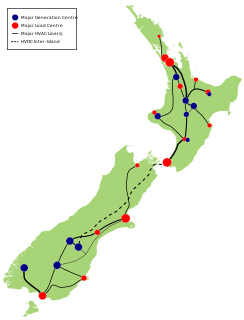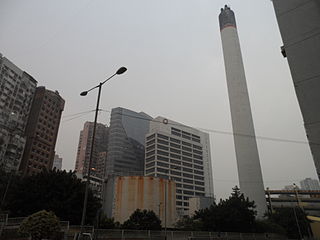Directlink (Terranora)Interconnector is a buried 59 kilometre High Voltage Direct Current (HVDC) electricity transmission cable route from near Lavertys Gap, 5 kilometres (3.1 mi) Southwest of Mullumbimby, New South Wales and Bungalora & connected via a 3.5km (2.2mi) AC Overhead Transmission Line to the NorthEast to the Terranora Electrical Substation @ Terranora, New South Wales New South Wales in Eastern Australia.
The East–West Interconnector is a 500 MW high-voltage direct current submarine and subsoil power cable which connects the Irish and British electricity markets. The project was developed by the Irish national grid operator EirGrid.
The electricity sector in New Zealand uses mainly renewable energy; such as hydropower, geothermal power and increasingly wind energy. As of 2019, 82% of electricity is generated from renewable sources, making New Zealand one of the countries with the lowest carbon dioxide emissions from electricity generation. Electricity demand grew by an average of 2.1% per year from 1974 to 2010 but decreased by 1.2% from 2010 to 2013.
Companhia de Transmissão de Energia Elétrica Paulista is one of transmission system operators of electric power grid in Brazil. The company is headquartered in São Paulo.

China's electric power industry is the world's largest electricity producer, passing the United States in 2011 after rapid growth since the early 1990s. In 2019, China produced more electricity than the next three countries—U.S., India, and Russia—combined.

An electrical grid is an interconnected network for electricity delivery from producers to consumers. Electrical grids vary in size and can cover whole countries or continents. It consists of:

The National Grid is the nationwide system of electric power transmission in New Zealand. The national electricity transmission grid is owned, operated, and maintained by state-owned enterprise Transpower New Zealand, although some lines are owned by local distribution companies and leased to Transpower. In total, the national grid contains 11,803 kilometres (7,334 mi) of high-voltage lines and 178 substations.

The Whakamaru to Brownhill Road transmission line is a double-circuit 400 kV-capable transmission line constructed by Transpower to increase the capacity of the National Grid between the southern Waikato and the city of Auckland. The line runs from the Whakamaru sub-station near the Whakamaru Power Station, over a distance of 186 kilometres (116 mi) to the new Brownhill Road substation near Whitford in southeastern Auckland. The line will initially be operated at 220 kV. From Brownhill Road, 220 kV underground cables connect the line to the Pakuranga sub-station in eastern Auckland. The project was the subject of considerable controversy and protest during the planning and approval stages. Construction of the line started in February 2010, and the line was commissioned on 30 October 2012. The transmission line forms the major part of a wider North Island Grid Upgrade project with a forecast cost to completion of $894 million.

Companhia de Electricidade de Macau – CEM, S.A. known simply as CEM or Chinese: 澳電 is a private public utility company with a sole concession to transmit, distribute, sell high, medium and low voltage of electricity in Macau. Besides, CEM owns an installed generation capacity of 408 MW.
The North Auckland and Northland (NAaN) grid upgrade project reinforced transmission into the Auckland Region and across the harbour to North Auckland and the Northland Region. It added new 220 kV transmission capacity to the National Grid by providing 37 km of underground cable between the Pakuranga, Penrose, and Albany substations.

Electricity Ashburton Limited, trading as EA Networks is a co-operatively-owned electricity distribution company, based in Ashburton, New Zealand.

Bihar State Power Holding Company Limited (BSPHCL), formerly Bihar State Electricity Board (BSEB) is a state-owned electricity regulation board operating within the state of Bihar in India. BSEB was established in 1958 as a statutory corporation under the Electricity (Supply) Act, 1948. As of November 2012, BSEB has nearly 1,700 officers and 14,850 employees. The derated capacity comes to just 530 MW. The BSEB was unbundled on 2 August 2011. Power Finance Corporation was the main consultant for BSEB's restructuring.

The electricity sector in Taiwan ranges from generation, transmission, distribution and sales of electricity, covering Taiwan island and its offshore islands.

The Macau Power Station was a gas and diesel-fired power station in Nossa Senhora de Fátima, Macau, China. Commissioned in 1973 for its first two units, it was the first power station in Macau. It was decommissioned in 2016.

The Coloane A Power Station is a low-speed diesel-fired power station in Coloane, Macau, China. With an installed capacity of 271.4 MW, it is the largest power station in Macau.

The Coloane B Power Station is a combined cycle gas-fired power station in Coloane, Macau, China. It is the latest power station in Macau.

Electricity sector in Hong Kong ranges from generation, transmission, distribution and sales of electricity covering Hong Kong. There are two main providers of electricity in Hong Kong.
Events from the year 2010 in Macau, China.
The high-voltage electricity substations in the United Kingdom are listed in the following tables. The substations provide entry points to, and exit points from, the National Grid (GB) or Northern Ireland Electricity Network. Entry points include power stations, major wind farms and inter-connectors from other countries and regions. Exit points are to lower voltage transmission and distribution substations which are also shown in the tables.



















